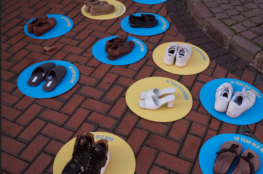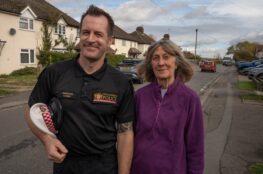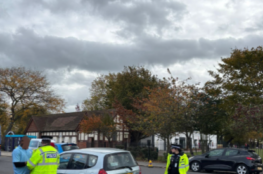As part of National Road Victim Month, the Safer Essex Roads Partnership (SERP) spoke to Barbara and Jimmy, a couple whose lives were changed forever by a serious road collision.

“If she hadn’t worn her seatbelt, she wouldn’t be here today.”
As told by Jimmy.
It was a cold and ordinary day in November, like any other. My wonderful wife, Barbara, had gone out for the day.
I was at home, practising my saxophone for an upcoming concert. I noticed missed calls had flashed through to my phone and at that moment, I remained blissfully unaware that it was Broomfield Hospital. When I answered, I didn’t think much of it at first- a broken bone, perhaps? Nothing urgent.
Then, instant panic. I felt the caller’s tone through the phone, and they told me to get to the hospital immediately.
We live in Thornwood Common, about 20 miles from Broomfield. It was dark when I made the drive and when I walked into the ward and saw Barbara in traction, flanked by two police officers, it hit me -this wasn’t just a bump in the road.
This was serious.
The collision that changed everything.

Barbara had been involved in a multi-vehicle collision at Howe Green- her Smart Car had been crashed into head on. The road was shut for six hours, with three vehicles involved.
One moment, and our lives were changed forever.
Myles Hilbery, then an Essex Roads Policing Officer, was off duty and out on his bike when he heard an incredibly loud bang.
Myles said: “You get used to recognising the sound of a collision, it never leaves you.”
“I stopped quickly and turned around. Barbara’s vehicle had significant damage, smoke was heavy in the air, hazards were everywhere, and debris had flown across the field. I could see Barbara, trapped in the car with what looked like a serious break to her thigh.”
He added: “I was in Lycra, wearing cycling shoes, totally unequipped, but my training kicked in. I stayed with Barbara, provided reassurance amongst the chaos, and directed members of the public to call emergency services. Her injuries were clearly serious, but I just wanted to keep her calm and focused.”
The physical and emotional aftermath
Life just stopped for my wife and I after that day.
Barbara was in hospital for over a month, undergoing multiple operations and she spent six months using walking aids and undergoing extensive physiotherapy.
She had a broken back, a fractured kneecap (which is now permanently wired), a shattered thigh (pinned with metal), crushed ribs, and her heel was completely destroyed and has now been rebuilt mostly from metal. Her recovery wasn’t measured in days or weeks- but years.
When I went to collect her things from the wrecked car, the damage was beyond comprehension, and I felt myself shaking. If she hadn’t been wearing her seatbelt, she would have gone through the windscreen. The force would have carried her over the truck. It’s chilling to even consider.
And then came everything else. The appointments. The outpatient visits. The trauma. The frustration and potential future of immobility.
The ripple effect of a collision
It’s not just the crash itself; it’s the ripple effect. The strain on families. The cost to emergency services and the fire crews who cut Barbara from the wreckage. The physiotherapy, the home adaptations- from the perch stool to the small step we bought just to help Barbara climb into bed.
A quiet moment of hope

People often talk about road collisions in terms of numbers. But behind every statistic is a person, a family.
During those early weeks of recovery, when Barbara could barely move, she had regular visitors- family, friends, neighbours and one very persistent robin who would appear at the window each morning. A small reminder that there’s still beauty and kindness in the world, even in the darkest chapters.
Finding purpose after impact
Since then, Barbara and I have both become Community Speed Watch volunteers. It’s our way of giving back, and of doing something practical to prevent others going through what we’ve endured.
I tell people: take the advanced driver course. Get a dashcam. Think twice before rushing. And always wear a seatbelt, because that one simple habit saved my wife’s life.
A message for National Road Victim Month
This is what road harm looks like. It doesn’t end with the sound of the crash. It lingers, in physical pain, financial pressure, emotional trauma and the long, uncertain road to recovery.
Barbara survived. But the journey changed everything.
If this story makes just one driver pause, check their speed, or buckle their seatbelt, then maybe something good can still come from something so painful.
Myles said: “The incident has stayed with me emotionally; the scene was traumatic- there was so much debris and the risk of fire was lingering throughout.”
“I don’t think people truly understand the consequences of collisions like these unless it happens to them. I’ve been in Roads Policing for 15 years and having dealt with families who have lost loved ones on Essex roads, I can tell you there is no comparison to the pain experienced by them. More people die or are seriously injured on roads than there are murders, a stark reminder.”
Support the journey to Vision Zero- a future with no deaths or serious injuries on Essex roads.
www.saferessexroads.org/vision-zero



